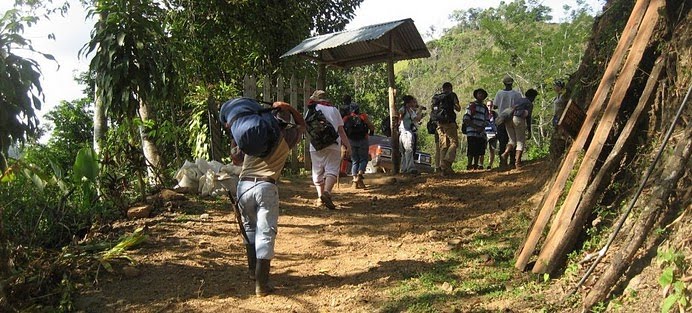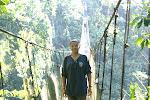Friday, February 5, 2010
Volcanoes in Costa Rica and Pittsburgh?
Friday, we learned a lot about Costa Rican geology and how it differs from where we live here in Pittsburgh. For starters, Pittsburgh doesn’t have any volcanoes. Costa Rica on the other hand has more than 5 volcanoes on its isthmus. All the volcanoes in Costa Rica are stratovolcanoes. This means that they have explosive eruptions. When volcanoes have explosive eruptions, they have sticky lava, and eruptions aren’t as frequent.
Because of these types of eruptions, it affects the society a lot. There were several instances to where people, mostly farmers, had to move away because the ash that was coming from the volcanoes wasn’t very healthy. It also ruined the crops they had planted. This is a problem because if the farmers don’t have anything to grow or sell, they won’t make a profit. Also people won’t get the food they need.
Who are the Ticos?

Alyssa, 17
Costa Ricans, also known as ticos, come from a variety of different origins, but share the same traditions and values in their country. These origins include the Spanish, Europeans (mainly German and Swiss), African slaves, and the Natives. Out of the 3.96 million people living in Costa Rica, only 40,000, or 1% are indigenous natives of Costa Rica. This is partially because many of the native Costa Ricans died of sickness when the Spanish colonists came to Costa Rica. Ticos live very peaceful lives, and are considered to be some of the happiest people on Earth. In 1949, after the civil war, Costa Rica created a constitution, in which the army has been abolished ever since. Ticos are proud of their neutrality. In addition, the constitution allowed Africans to be granted citizenship and women were allowed to vote.
Tico society is far from urban, and Costa Rica has the highest rural population density in Latin America. The only true city located in Costa Rica is San Jose, the capital. Rural ticos live a simple life, spending time tending to animals and crops, or as cowboys in Guanacastae. The three most popular crops grown in Costa Rica exported to other countries are bananas, coffee, and sugar. Also, the vast majority of ticos retain ties to the land, including those who live in the city. Homes often have a small garden if they are not located in the rural parts of the country. Costa Rica’s geography includes volcanoes, rainforests, oceans, and beaches. Costa Rica is also considered an isthmus because it is connected to land on the top and bottom, but is otherwise surrounded by water. To the west, the country is surrounded by the Pacific Ocean, and on the east, the Caribbean Sea. I look forward to being able to see the country of Costa Rica as well as the ticos culture and traditions.
Geology of Costa Rica and how it differs from Pittsburgh

Nathan, 17
During the past two days in class we have been studying the geology of Costa Rica comparing it to Pittsburgh’s. What I gathered from these activities were the different kinds of volcanoes, the types of eruptions, the hazards, and the advantages. There are three types of volcanoes in the world. These are shield, cinder cone, and composite. Shield volcanoes are volcanoes that are made of basaltic lava and that are really flat. Cinder cone volcanoes are made of pyroclastic rock, and these are volcanoes that look like pointy mountains. The last type of volcano is composite volcanoes. These volcanoes are made up of different layer of pyroclastic, and lava flows. Costa Rica is mainly full of composite type volcanoes. These volcanoes mainly have eruptions that are explosive and spew out gases. The hazards of volcanoes in the short run are that the gases are deadly, and lava flows are very dangerous. The advantages of volcanoes are that the heat produced by the lava can be stored and use to produce electricity. Another advantage that volcanoes give is that the ash is very useful for growing coffee beans, and bananas because the soil becomes so rich. The biggest reason to why there are so many volcanoes in Costa Rica and not in Pittsburgh is the tectonic processes of the Earth, and where the plates are located. Costa Rica is on the edge of a convergent boundary which means that the two plates run into each other and form mountains/volcanoes. Pittsburgh on the other hand is nowhere near the edge of a plate boundary which means there are no formations of volcanoes. During the assignments in class we used Google Earth to help us learn about tectonic plates and the volcanoes of Costa Rica. We had to find out where the closest tectonic plate boundary was from Pittsburgh. The closest one to the east is 2,209.41 miles. The closest one to the west is California. Other things we looked at using Google Earth was who close the nearest volcano was to San Jose. The closest volcano is Barva which is 13.29 miles away from the city. Then we had to find out where the closest plate boundary was to Costa Rica. The closest boundary is 90.45 miles off the western coast of Costa Rica. Another interesting fact that I found out was that a lot of the volcanoes in Costa Rica are very active.
All information came from information we learned in class, Google Earth, and the National Geographic Costa Rica Book.
Tuesday, February 2, 2010
Costa Rican Geology vs. Pittsburgh
 Melina, 17
Melina, 17I've learned recently that there are plenty of volcanoes in the country of Costa Rica. Here in Pittsburgh, there aren't any volcanoes because the state isn't located near any tectonic plates that could clash and cause volcanoes/mountains to form. On the other hand, Costa Rica is located between two major tectonic plates, those two being the Caribbean plate eand the Cocos plate. These plates are convergent because they aim towards one another and the plates collide causing volcanoes to form more often throughout Costa Rica. Convergent boundaries form volcanoes that produce andesitic lava, this lave type is sticky, light in color, and has little iron in it. It's known to have highly explosive eruptions when they happen to occur. Out of the major volcanoes in Costa Rica, all but one have andesitic lava and explosive eruptions. One thing they all have in common though it that they all are stratovolcanos meaning they are composite (having explosive/calm eruptions). These volcanoes can affect many of the Costa Rican people at the same time because of the amount of ask that comes from them and gets into the air and causese harm to the surrounding environments. Some of the positive effects that volcanoes have on the environment are the facts that later on down the road these ashes can becme useful because it's full of useful minerals and produces fertile soil for farming. Another advantage of volcanoes is the fact that they provide heat which later turns into electricity, also known as geothermal energy. To Pittsburgh, our closest neighboring volcano would be 1,849.18 miles away. But like mentioned earlier, Pittsburgh doesn't have to deal with active volcano eruptions because of not being surrounded by active tectonic plates that would cause this.
Monday, February 1, 2010
Who are the Ticos?

Emily Stanley, 16
When talking about who “ticos” really are, we seem to think about their government, and past, but what I really think we ought to look at is their real lifestyle that they live every day. One example of this is their religious practices, which consist of 76.3% of the population being Roman Catholic, and 13.7% being Evangelical. Whereas there are much smaller numbers for those who are other religions, such as there being only 1.3% Jehovah's Witnesses, and the other Christian faiths being .7% Protestant. For something completely outside of Christianity, there is the other 4.8%, and 3.2% of the population claim to have no religion at all. However, because of a recent and small immigration from Asia and the Middle East, there are other religions starting to develop more, but specifically Buddhism, but there is a Jewish synagogue in San Jose.
Costa Rica has written and revised its Constitution during all its political trials and tribulations overtime, and through this document, is how they will function in society, as holds true for every society. Costa Rica has one of the most stable countries in its region, which obviously must hold true for its people’s decision making skills, and they have relatively high level educations, and it has a literacy rate of 97% one of the highest in Latin America, making it a very well educated country, more so than most, with educated people.
Though Costa Ricans seem to have an educated mind, they can still enjoy life. While having a well set up government, they have a culturally varied history. Because of the immigration of the Spaniards, the use of Spanish language, and the Catholic religion, it remains to this day some of the main cultural aspects of the country. The old style dances, such as Costa Rican swing are big musical influences in the lives of older citizens, where as things like Reggaeton and American Pop, are most popular among the youth of the country. Through those dances, guitar when accompanied to folk music is a popular aspect of culture. The Department of Culture, Youth, and Sports, runs most funding on these areas, where they are having trouble with funding for smaller activities; the common activities are easily paid for, and remain high quality forms of entertainment. These are a culturally diverse people, who are maintaining a stable government, while still attempting to have an enjoyable life.
- Emily Stanley









